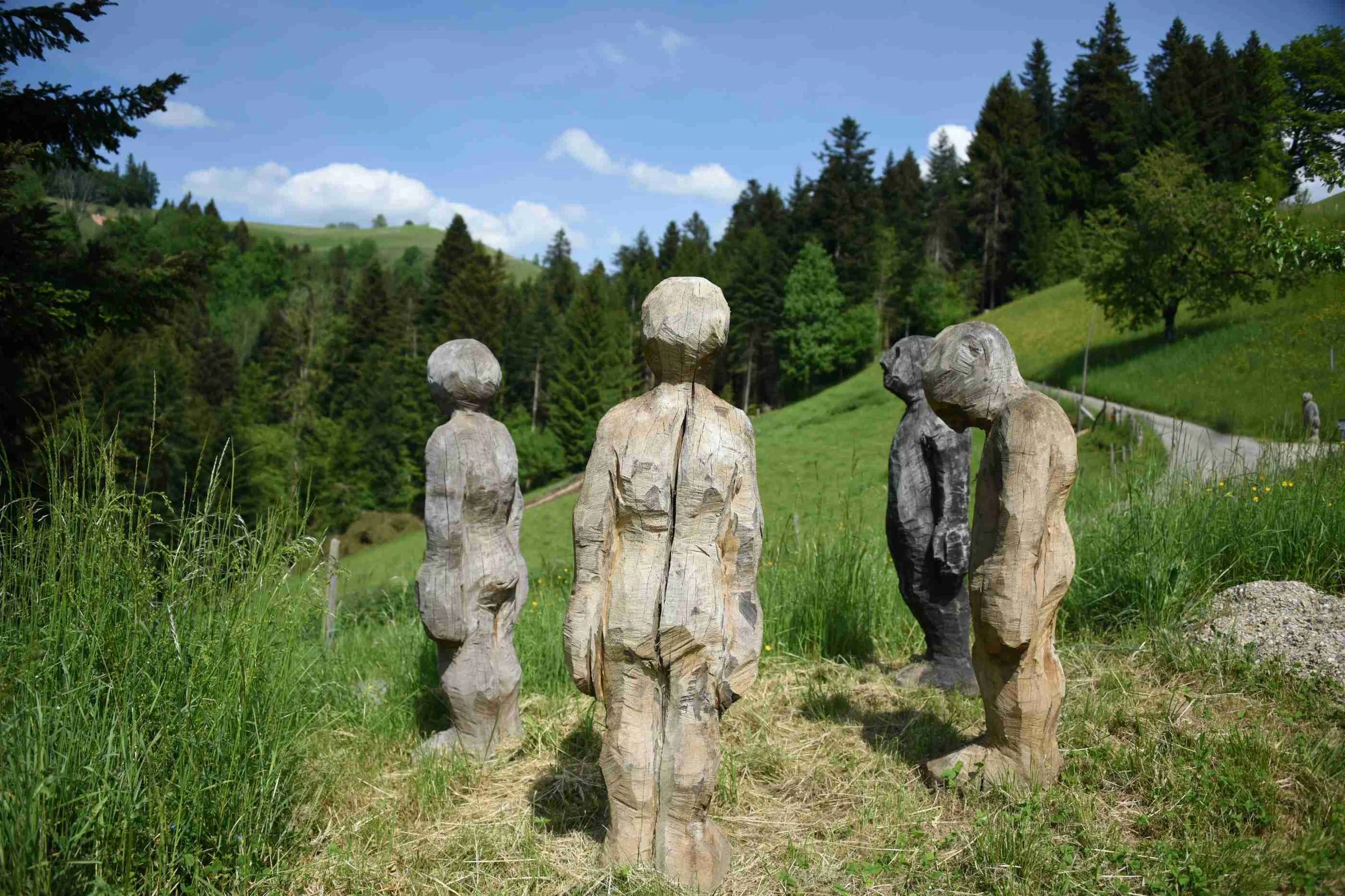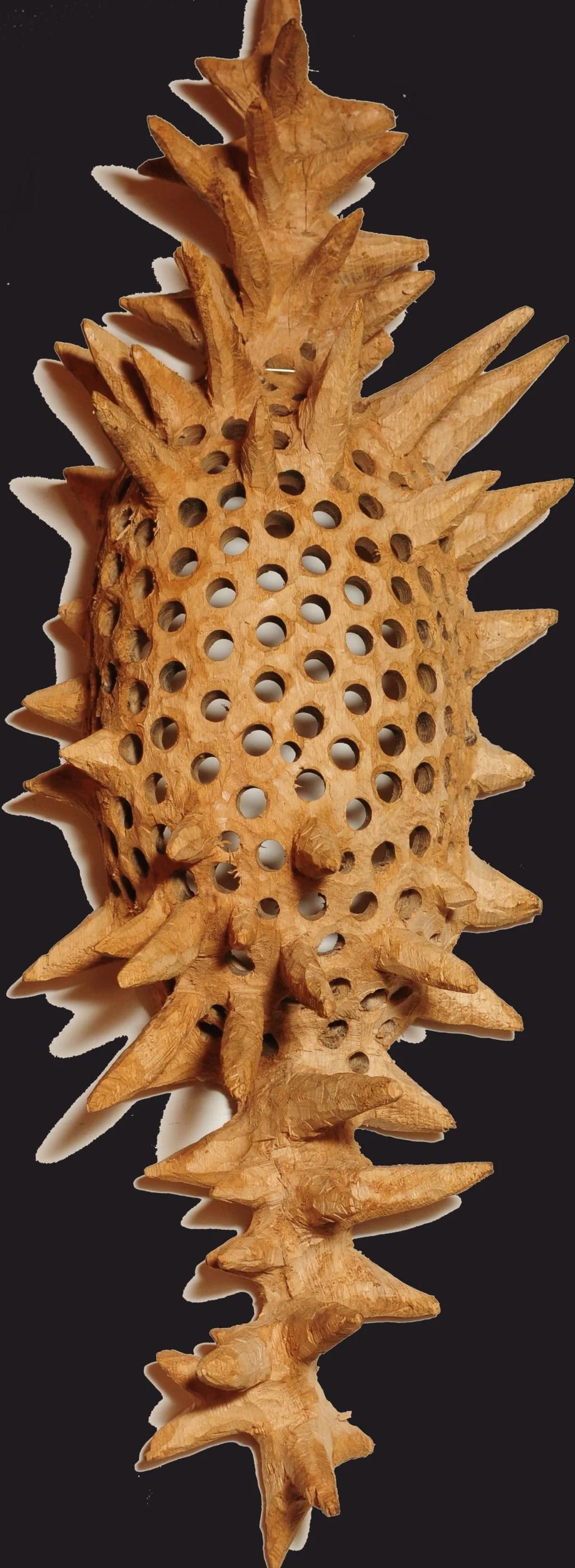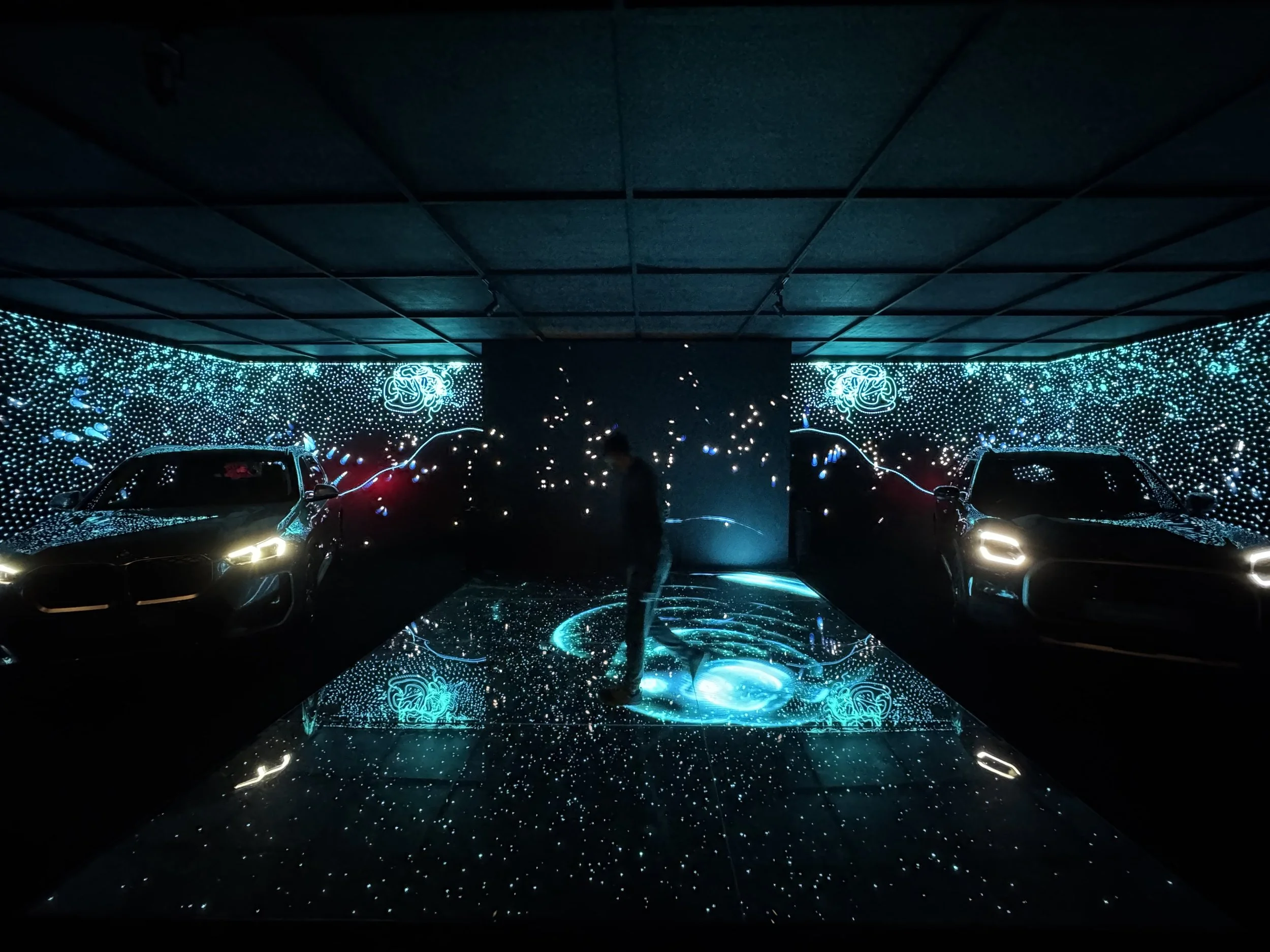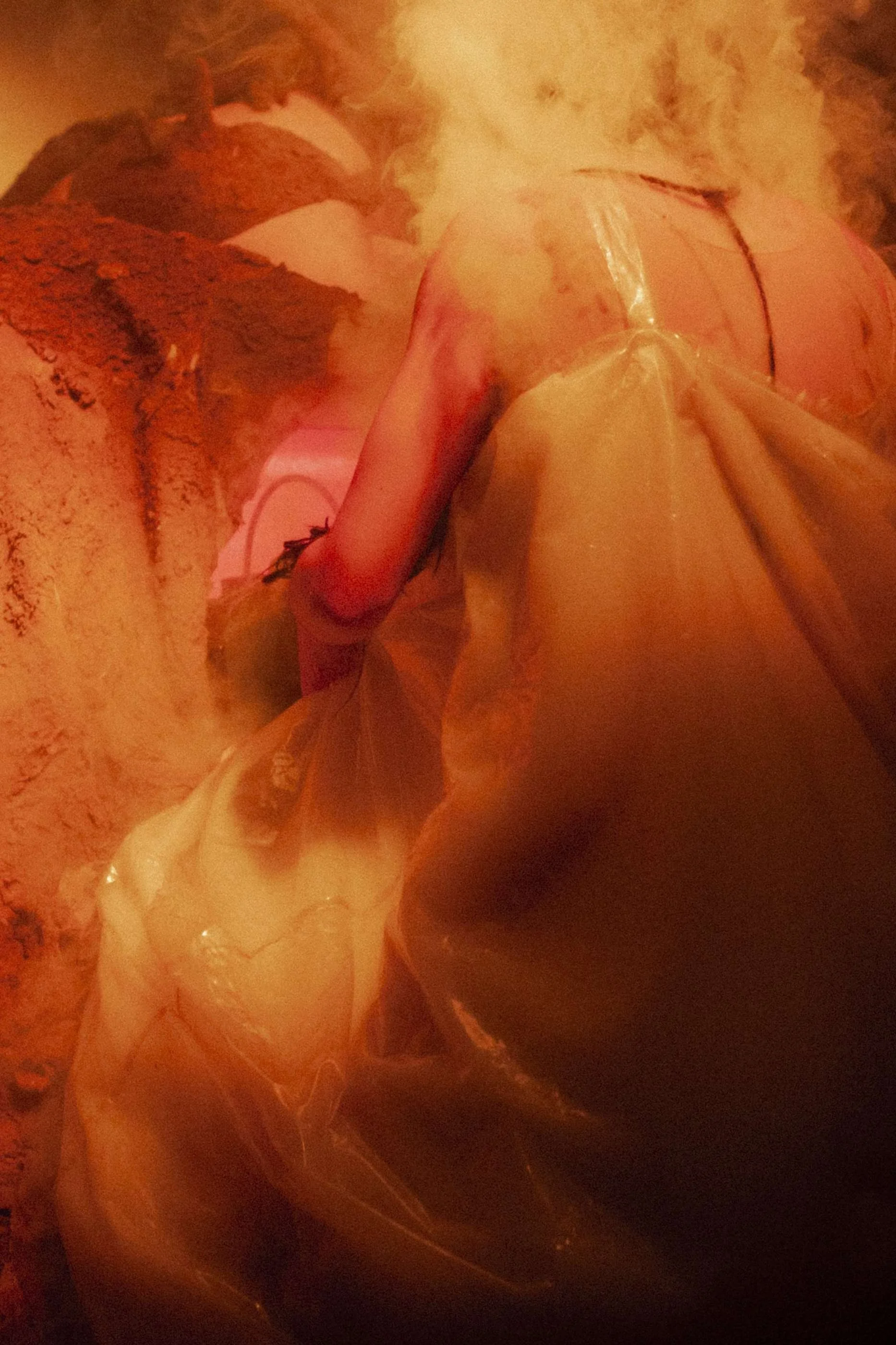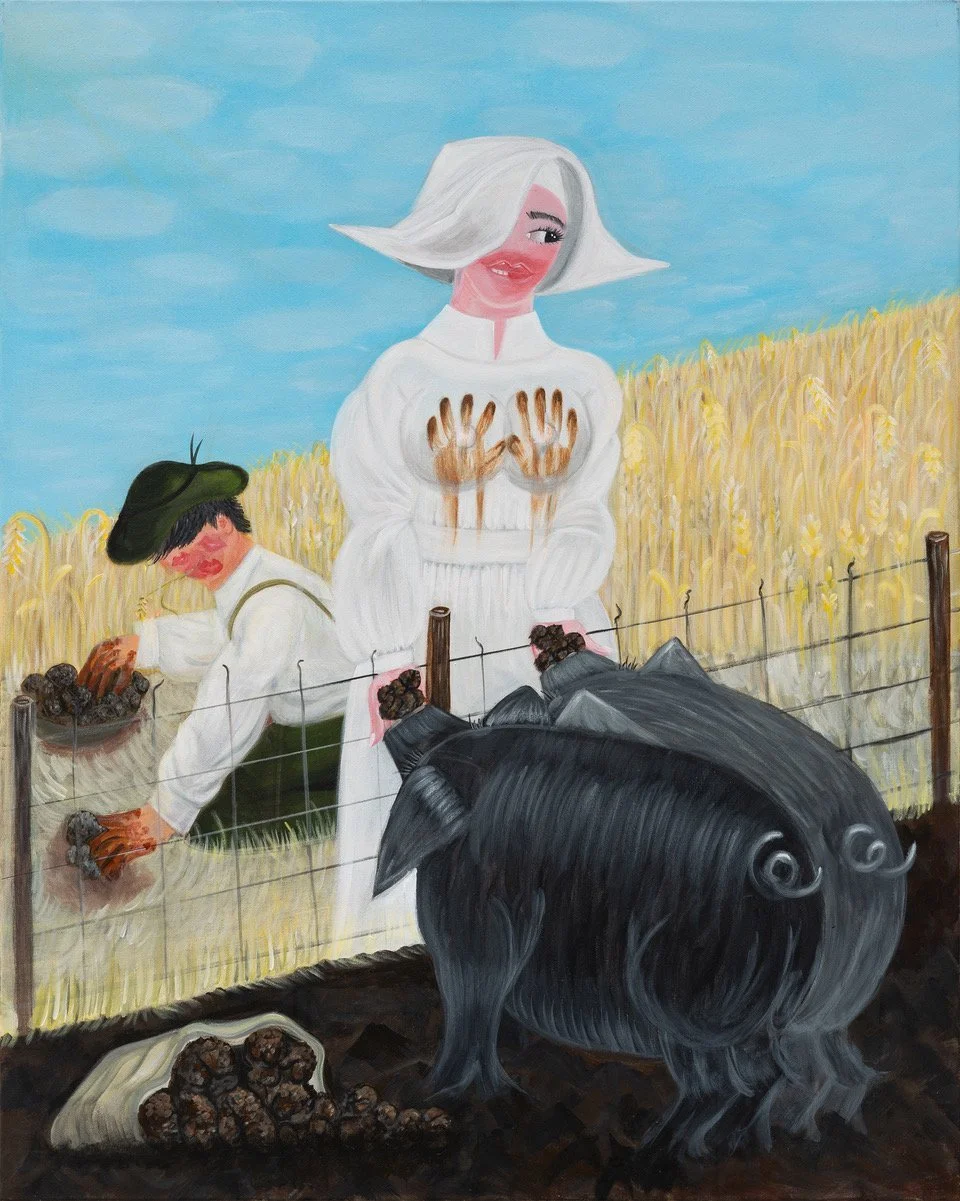Werner Neuhaus
Gasmaske I: oak, jute, aluminum, 2007 90 x 160 x 85 cm
Werner Neuhaus zoomorphic sculpture remains ever dramatic. A high-pitched cry within the silence that pierces the meadow, the forest, the green fabric that ventures into the cave and penetrates the lair. The eyes of his Gerechte are hollow, between a rough tongue of wooden nose.
The pupils seem to have been scraped out - as though by a hand in the mud - by a tear, a thought, a memory. In these excavations, like resting places of uprooted hearts, discolorations arise in shades of wolf-gray, fur-cream, bark-beige and tearful-blue. The hands, resting against the body, are burdensome, disproportionate, weights not meant to act but to signify their immobility, because the physical body, of which the hands are primary messengers, is not the subject of this cry, but rather its soul.
Neuhaus lives in the Swiss mountains, he owns an art farm called Wanner 433, hills, forests and sheep, as well as a career as a sculptor and one as an Alpine shepherd. I visited him and the art farm where he lives, an openair museum scattered of oak, theriomorphic, chimerical, post-apocalyptic human figures, and monumental wooden radiolarian structures. Let's ask him the hows and the whys.
Gerechte, detail 2 oak, 2001. each 150 x 65 x 75 cm
Frau mit Pestmaske: detail oak, 2019, 155 x 75 x 55 cm
What was it like to spend most of your life in the mountains and in nature? And above all, what introspective experiences have shepherd life and the time spent in the Alps triggered in you?
As a child, I had two career aspirations. One was to be a shepherd, the other a visual artist. I have practiced and am currently practicing both professions, gladly. I have being a shepherd for 15 summers on the mountains. There, the immediacy of the experience, the contact with nature and the animals, the strict daily routine around the cattle, the milk processing and its end product, the cheese, touched me a lot. A closed cycle in the middle of a barren mountain world.
This direct experience in the midst of nature, by living together with the animals has had a decisive influence on my work, as well as the eccentricity of the bare mountain world and its moodiness. At times, it's like testing the limits of physical endurance. A summer cold snap above the tree line can turn an alpine farm into an inhospitable, hostile place. I made a direct reference with the work Red Cow: a cow lying on the ground with its head turned away and its belly seemingly distended. The scene can be the drama of death or the sleep of a healthy cow, whose rumen bulges upwards as a result of lying on its side. The question is the decisive moment of contemplation. There is no final answer.
The first wolf kills in the Upper Valais at the beginning of the 2000s were a key experience for me. They were sheeps from the neighboring alp, but they were killed on my cow pasture, so very close to me. Especially in Valais, the atmosphere was very heated. The whole controversy surrounding this predator interested me very much. Wildest stories circulated among the population. There was a widespread opinion among sheep farmers and hunters that extremist animal rights activists were bringing the wolves illegally over the border from Italy into Switzerland at night and fog. This gave rise to modern legends. I had only witnessed dogs!"kills before, and so the hypothetical proximity with a wolf nearby, which one!s practically never gets to see and yet, at 2200 m above sea level, could be a direct neighbor, fascinated me very much.
Gasmaske I: oak, jute, aluminium, 2007 90 x 160 x 85 cm
Rote Kuh: painted oak, 2006 90 x 120 x 240 cm
Why did you feel the need to make art, and what are you looking for in sculpting? What do you meditate on?
Reflecting on the tension within the lived reality and placing it in an artistic context is certainly one of my core concerns. Direct access to art from my own life has always been important to me. Be it as a shepherd, asbestos removal worker or traveler.
An active, emancipatory approach to the works, in the sense of a questioning that creates space for liberation from ingrained thought patterns, is another of my main concerns. Also, my artistic work must always be linked to concreteness: reflecting on something that I can touch with my hands, that exists in its phenomenal tangibility.
Gerechte: detail, oak, 2001, each 150 x 65 x 75 cm
Why do some of your sculptures wear a mask?
Initially, I only depicted human bodies with animal heads. Animals, humanoid intermediate beings. The animals were somehow closer to me. Later I turned to the mask. So the plague mask, in the form of a bird's head, is a synonym for people's striving for protection from illness and death. But also an expression of a drama taking place. My travels to Syria and Iraq inspired me to work on this. Despite their vulnerability, people there can endure the inevitable with a stoic calmness. And what about the beauty of peoples!"vitality which leads them to clear away the rubble and rebuild during or after a conflict.
The mask then symbolizes the contrast according to which these people in extreme situations try to live normal lives. I remember of a woman playing with and feeding a dog at a checking point (hence Frau mit Hund as well as Wolf mit Maske I and II). In the participatory art projects I organized in Syria and Iraq, I was then able to join and enjoy this vitality from the people there. Nevertheless, it is also important to be careful, as you also generate hope that you can't fulfill. People there live in a different reality: while I go back home, afterwards, they stay there. The loss of some of my Syrian friends, who have been killed in the war, it is a sad example of this tragic situation.
Another meaning of the mask is related to my job in asbestos removal where the face mask is an important part of protecting the airways in the decontamination zone.
Gasmaske II: detail: oak, jute, aluminum, 2007 150 x 65 x 75 cm
Frau mit Hund: eiche, rubber, aluminium, 2016 190 x 100 x 90 cm
Wolf mit Maske I: oak, rubber, aluminium, 2016
The organic structure of many of your works is quite unusual and really fascinating. Does it refer to something in particular?
It is bio-sculpture, we could say: they are radiolar, skeletal forms of single-celled organisms, microscopically small. Converting them in a much larger dimension with oak wood fascinated me. A kind of reflection to better understand the process of the evolution.
Spiessrutenlauf: oak, 2015, 38 x 130 x 23 cm
Früh am Morgen: oak, 2012 ,60 x 85 x 23 cm
Entzweiung: oak, 2014, 38 x 140 x 24 cm
This looks like a comprehensive survey of the iconography of all your works, lol: what do those figures with the elongated noses mean? I imagine there is an interesting story also behind them...
The mask comes from two iconographies. It is the plague mask, a medieval garment that people, especially doctors and corpse bearers, used to protect themselves from infection. Hence the bird-like nose or, if we want, the beak as a protection from illness and death (this protective feature, at any rate, has been proven to be only imaginary and ineffective). I derived the other from the extremely mysterious bird-man found in the famous Paleolithic graffito of Lascaux, one of the first very detailed depictions of a human being and the first ever as a bird. This captivated me a great deal.
And what about your Flaschengeist [Genie in the bottle]?
The genie is a mythical figure from the Orient. I've traveled a lot around countries like Iran, Iraq, Syria, Jordan as I highly enjoy the vitality and the authenticity of these people and I am in constant exchange with artists from there. The genie, a so-called jinn, is a servant spirit that is banished into the bottle. Over time it was also adapted by western poets: he appears in Goethe's “Faust”, where he is magically conjured up as Mephistopheles or as Paredros. Among the Greeks there is Pandora's box, a negative evaluation of the banished spirit, as the box is equated with the beginning of great misfortune. Then freely adapted from Schiller (“I called the ghosts, I can't get rid of them!”). This could also be applied to current political developments. There are presently too many old powerful men who want to implement their anachronistic, chauvinistic world views and who have been democratically legitimized.
Another interpretation of the genie in a bottle would also be that one of a projection surface for one's own wishes, or as the antithesis of their own fears that they are trying to keep under wraps.
Vogelmensch Kniend: detail oak, 2016, 160 x 40 x 50 cm
Vogelmensch Kniend: installation view
Do you have new projects in mind?
Yes, I'm currently working on an art project called In the Zone that involves asbestos removers and thus the participation of people. It takes place in a renovation zone and therefore only accessible by the asbestos removal workers. The reference that plays here is my past experience as an asbestos removal contractor. I am very glad to be working with my former colleagues: this is a very international environment, as Swiss people are rather rare in this work. The actual artistic work will be ultimately created in the asbestos repository itself, hence reflections on sustainability and eternity also play an important role.
I am also in the process of setting up an alpine hut, at the top of the hill of the house, as an exhibition space, as well as setting up an artists' residence in one of the farm chalets, which already houses three floors of exhibition space for art shows. Artists of all fields are welcome.
Gasmaske II, III: installation view
What to read next







